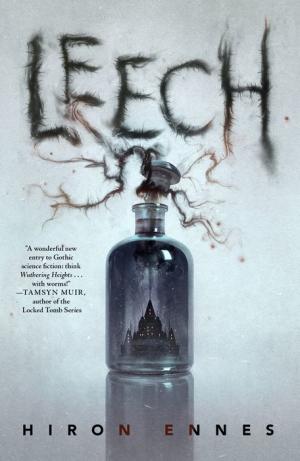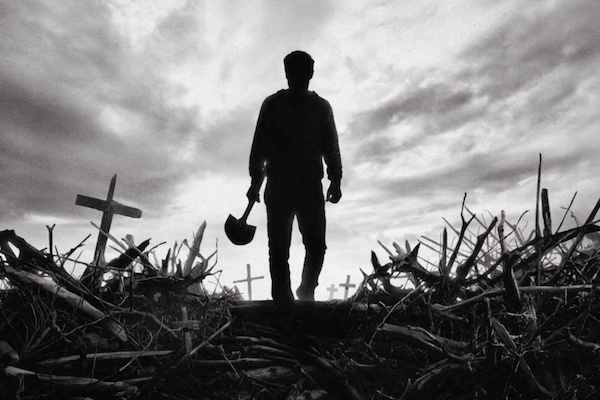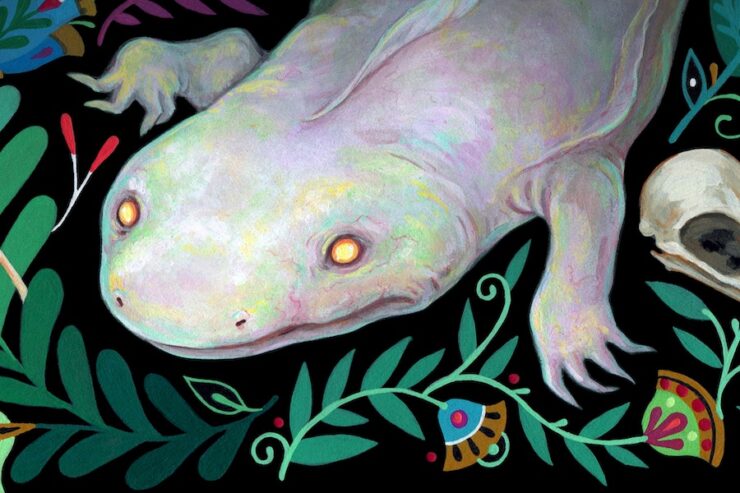Welcome back to Reading the Weird, in which we get girl cooties all over weird fiction, cosmic horror, and Lovecraftiana—from its historical roots through its most recent branches.
This week, we cover Gordon B. White’s “Gordon B. White is Creating Haunting Weird Horror,” first published in the July 2021 issue of Nightmare Magazine. Spoilers ahead, but this one is both short and very much worth the read!
“A little girl with a mouth like a dripping bloom of wilted carnations hunts them from three a.m. until dawn. She doesn’t like to be looked at.”
You, the unnamed narrator, follow Gordon B. White on Twitter and have enjoyed his stories, so you decide to subscribe to his new Patreon. You choose the $7 tier, Postcards of Lesser Known Haunted Houses. Why wouldn’t you?
The next month, you receive a postcard mailed from Seattle. The one-story Craftsman on the front looks entirely ordinary. On the back, a cramped hand has written a microfiction about “1247 Sawtuck Road.” The Craftsman is haunted by a boy with “the face of a stillborn Janus kitten and scissor blades protruding from under his eyelids. When he cries, he goes snip-snip.” Whisker cuttings appear in dusty corners.
That’s all for your $7? You toss the postcard on a mail pile doomed to be discarded unread. That night you dream of blades, and hair falling on your face.
Next month’s postcard features a boxy Tudor-style with a pink bicycle lodged in the unkempt hedges. “329 Mantooth Drive” shelters a ghost-bird and ghost-mouse and a carnation-mouthed girl who hunts them in the wee hours. You go to throw “Mantooth” away along with “Sawtuck,” but you can’t find the older postcard, and suddenly the new one’s gone too. All night you hear scratching in the cabinets; you wake to “a sweet smell that could be flowers or rotting meat or just your imagination.”
Buy the Book


Leech
You’re not scared, just thrifty, so you cancel your Patreon pledge. You unfollow Gordon B. White, to find he’s already blocked you and closed his DMs. You were right to drop him—what’s worse than an “artist” who disses his fans?
The next month brings “14 Continental,” a crumbling Victorian. The final owner left behind the severed heads of three bearded men, radio speakers crammed in their mouths. Though silent, they appear in inappropriate places, like the fridge on hot days and the oven on cold ones. Now you hesitate to open your appliances. Patreon and your credit card company confirm you haven’t contributed to White in over a month.
Next month, “1415 W. Cherry,” in which one step is heard on one stair every one a.m. Children say if you stand on the stair, you’ll see “Old Lady Winter.” Adults know you’ll die.
The postcards keep coming, featuring houses haunted by a footless Confederate general looking for his boots; a young maid “stitched of spider-silk wedding veils” who fears getting married; a whole family “tangled like a knot, rolling behind the walls.”
The ghosts insinuate themselves into your dreams and spill over into your days: the smell of burning beard-hair in your oven, lipstick prints on your mirror, deformed cat-paw prints on your comforter, a loose-lidded red hatbox in your bedroom closet that trembles and whispers when trucks drive past.
At last a postcard arrives without stamp or postmark, and the pictured house is your own. You stand in a window in yesterday’s clothes, frowning. In the bushes beneath another window are shadows, and perhaps a shape. You know what the shape is.
With blue-stained fingers, he pried open the window and crawled inside. For months he’d been sending his friends ahead of him, “until the beams were rotten with ghosts.” “They would live here. Forever.”
You turn on all the lights. Your laptop sits on the coffee table where you didn’t leave it, screen dark and waiting. The greasy trackpad leaves an inky smudge on your fingers. A wall bulges, then flattens. A truck passes, and in the bedroom something snickers.
Your browser’s open to Gordon B. White’s Patreon page. Highlighted are two new support tiers. For $8 monthly, White will remove one ghost and send it far away. For a single, much larger sum, he’ll dispel all the ghosts at once, putting them in a single story to haunt other readers.
You sign into your Patreon account. Scissors snip, carnations waft their scent, the stair creaks, something shuffles beneath the floor. Then all the manifestations pause, waiting for you to enter your credit card information.
What’s Cyclopean: The postcards start with “kitschy” stamps and ordinary-looking houses with a “vibrance” to them. But by the final postcard, hauntings have become all the problems that can keep a homeowner awake at night, “beams rotten with ghosts” and nightmares “like black mold in the walls.”
The Degenerate Dutch: 765 Warwick is haunted by a Confederate general who can find neither his boots nor his feet. You are not particularly sympathetic to Confederate generals and definitely don’t want one un-living in your house.
Weirdbuilding: Hill House only wishes it had the ability to mail postcards!
Libronomicon: Who needs a thick tome when you can have microfiction?
Madness Takes Its Toll: Of course you’re not scared—but still, is that flower/meat smell real, or only your overactive imagination?
Ruthanna’s Commentary
Every haunted house has a story about how it became haunted. Perhaps it’s a notoriously malicious “hanging judge.” Perhaps it’s an alien fungus or a toxic hoard. Perhaps it holds its origins tight, letting loose only conflicting rumors. But suppose those stories, rather than being tied to their place of origin, were… transferable?
It’s a very different way of thinking about the place-bound trope of haunting, but a very modern one. After all, the internet is a place in its own right, one in which the boundaries between other places sometimes blur. Where a malicious whisper from the other side of the world can claim to come from next door. Where microfictions and creepypasta give new life to the hoary forms of urban legends.
There is something extremely urban-legendy about White’s micro-hauntings. The quick, sharp images would be at home around a campfire. They’re designed to make you avoid looking out windows (or into closets and ovens). Is a kitten-boy with scissors for eyelids, who goes “snip-snip” when he cries, dangerous? It’s not clear how he would be. Do you want to see him? Hear him? Me neither.
Even at their worst, these haunts remain disturbingly deniable. Who hasn’t been unsure of a smell, or lost a postcard in a pile of iffily urgent mail? And yet, there’s no real question what’s causing all these half-sensations and rattling hints. No question what it means when that final postcard arrives.
I’m coming back to this story after two weeks of thought-provoking cons, including a panel on the infamous second person point of view at the Nebulas, and a glorious dive into unusual story forms at Wiscon. White combines both, a second-person tale built around the form of Patreon-funded microfictions. It’s an effective approach to horror. If you’ve ever signed up to casually support a favorite artist, only to wonder later if you actually have time to catch up on all those articles, or if the daily cat pictures are a reasonable apology for the lack of more complex content, you could easily be White’s “you.” (I’m projecting here—I don’t so much stress over what my own favorite Patreon artists produce, as over the irregularity of the Q&A answers and drabbles and care packages that I’m supposed to be sharing with my own Patrons. It has not been an era for consistent creative schedules.)
White also combines the readerly fear of literally getting lost in a story with hints of the complementary authorial horror. “You” resent White’s ostensible failure to take a “personal interest” in his followers, an impossible balancing act whose failure modes range from George R.R. Martin (still not your bitch) to King’s Misery. If your stories haunt your readers and keep them up at night, shouldn’t that be enough, even if you don’t follow them on Twitter?
Gordon B. White does seem to have hit on an effective money-making method. There’s a trace here, again, of more familiar urban legends: the goblin market, the deal with the devil that requires further dealing to get out of. But that’s life online, isn’t it? Is it really more terrible to get that “personal touch” from an individual creator, or to quietly trade snips of soul and name for access to Facebook? Is pedestrian identity theft that much better than whatever’s whispering in your closet?
Maybe it is. Better the devil you know and all that. Either way, be careful where you share your address. Not all devils have an “undo” option—at any cost.
Anne’s Commentary
In my antediluvian day, parents warned their children to beware of strangers, meaning those who might pull up their car next to you when you were innocently walking home from school, no thought in your sweet little head except how you might wheedle your mother into letting you stay up late to watch Star Trek (TOS, no less.) These strangers would offer you candy. If you took it, or even stopped long enough to say “No thanks” (because your parents also taught you to respect your elders), something VERY BAD would happen. Strangers would kidnap you and lock you in a basement and DO THINGS to you.
My friend Susan, who was sophisticated, told me what DOING THINGS meant. Thanks, Susan.
These days parents still warn their children about Real-Life Strangers, but they must also caution against Virtual Strangers, the ones that lurk behind the bright-lit screens of phones and laptops. We no longer need to scrawl pentagrams or visit mysterious monoliths deep in the woods in order to summon demons. We have only to log on to the Internet and reach for the wrong digital candy.
Among modern cautionary tales is Joe Hill’s Heart-Shaped Box. Its protagonist collects macabre items like a witch’s confession and sketches of the Seven Dwarfs by John Wayne Gacy. One day he learns about an online auction for a haunted funeral suit. He can’t resist such a pitch, and soon the suit arrives in the titular box. Sure enough, a ghost arrives with it, and sure enough, he is not a friendly ghost.
At least Hill’s Jude Coyne was informed upfront he was buying a haunted item. Gordon B. White doesn’t warn his Patreon supporters that along with their “Postcards of Lesser Known Haunted Houses,” they’ll be receiving bonus revenants. Not cool, Mr. White. Though I suppose that even if he’d included a disclaimer about the ghosts, the vast majority of his fans would just have snorted in cynical amusement and signed up anyway. Yeah yeah, ha ha, free supernatural manifestation with every postcard, the Spook-of-the-Month Club. The kind of semi-lame joke you’d expect from a guy who writes weird fiction.
Disclaimer or (as in this case) no disclaimer, who can blame White’s narrator for snapping up the lure? I admit I would have opted for that $7 tier, too. Weird microfiction can pack a kick well beyond its weight class, same as a few viruses in the right (non)immune system can trigger devastating disease. Microfiction has room only for the germ of inspiration, an image or two, a bare hint of plot, of character, of setting, of conflict. If the images are sharp enough, the hints sufficiently compelling, they can powerfully engage readers’ imaginations, spawning multitudes of dreams, sleeping or waking. White stuffs his short-short story with seven truffle-rich micros, then ties up the whole candy box with a ribbon woven to connect the individual offerings. Pow, what about a ghost with the conjoined faces of stillborn kitten-twins? Pow, what about a girl-ghost with a mouth like wilted and bleeding carnations? Bang, severed heads haunting kitchen appliances! Zowie, the one a.m. stair-step of death, and the footless general, and the spider-silk-veiled reluctant bride, and the knotted-together family in the walls! Pow-Bang-Zowie—the laptop smeared with the blue ink from White’s postcards, and open to new tiers on White’s Patreon’s page, when the narrator finally understands the trap into which they’ve been led.
Luckily, if infuriatingly, there’s a way out via credit card. Let’s hope the narrator has a big enough balance to choose the get-rid-of-all-ghosts at once option. Whoa, wait! Narrator must have a big enough balance, because aren’t we all reading the single story into which White has shoe-horned the ghost-hoard? Wait further! Doesn’t that mean we’re all haunted now?
Gordon B. White is a diabolical genius. Now he has only to write a novel about the ghosts with which he’s haunted all the readers of his short story, and then a sequel novel about all the ghosts with which he’s haunted all the readers of his first novel, and so on into an unending series of novels and the evil author’s own ungodly enrichment.
Unless—
Unless we readers don’t read any more Gordon B. White! Wouldn’t that just serve him right, his ghosts having no other head to haunt but his own? That’ll teach him to play around with the fictional nuclear option of meta! Yeah, instead of his second person narrator being each reader he addresses, his second person narrator may play that other second-person trick of actually being a first-person narrator one step removed, the writer addressing himself as if a second person! As in my first paragraph above, come to think.
Take that, Gordon B. White, you fiend.
Next week, we start on our next longread: N. K. Jemisin’s The City We Became!
Ruthanna Emrys’s A Half-Built Garden comes out July 26th. She is also the author of the Innsmouth Legacy series, including Winter Tide and Deep Roots. Her short story collection, Imperfect Commentaries, is available from Lethe Press. You can find some of her fiction, weird and otherwise, on Tor.com, most recently “The Word of Flesh and Soul.” Ruthanna is online on Twitter and Patreon, and offline in a mysterious manor house with her large, chaotic, multi-species household outside Washington DC.
Anne M. Pillsworth’s short story “The Madonna of the Abattoir” appears on Tor.com. Her young adult Mythos novel, Summoned, is available from Tor Teen along with sequel Fathomless. She lives in Edgewood, a Victorian trolley car suburb of Providence, Rhode Island, uncomfortably near Joseph Curwen’s underground laboratory.














I love it when you choose a Long Read from my To Be Read Ambiguous Geometric Structure.
Is the better deal to get rid of all ghosts at once or have them removed month-by-month?
@1- I agree!!
Um… how much of City are we supposed to read?
He totally does though! The title is a pun. Haunting weird revenants.
So by reading this story, are we the ones who get haunted by all the ghosts at once? Well done!!
This one was great fun. You could tell White was enjoying themselves.
Ohh, City We Became! I thoroughly enjoyed that. Looking forward to what RtW has to say.
Hi, all!
As many of you will remember, we read “The City Born Great” a while back. The short story, almost verbatim, is the Prologue of the novel. What we’ll mainly cover in this week’s post are the next two sections: “Interruption” and “Chapter One: Starting with Manhattan.”
Cya soon!
Anne
“We no longer need to scrawl pentagrams or visit mysterious monoliths deep in the woods in order to summon demons.”
Sigh… I wish my woods had mysterious monoliths!
Anyways, I read this story at night before going to bed, and after I finished I thought, “If I hear scissor noises in my dreams, I’m going to be really annoyed.” Or freaked out, more likely. If I had dreams, though, I didn’t remember them. What I read almost never shows up in my dreams, unfortunately. Even my favorite, several times reread book series has only popped up two or three times over many years.